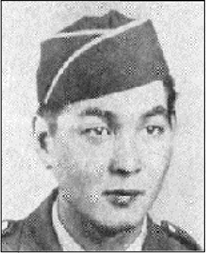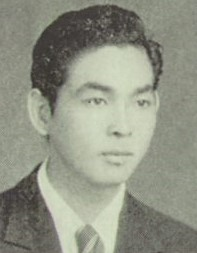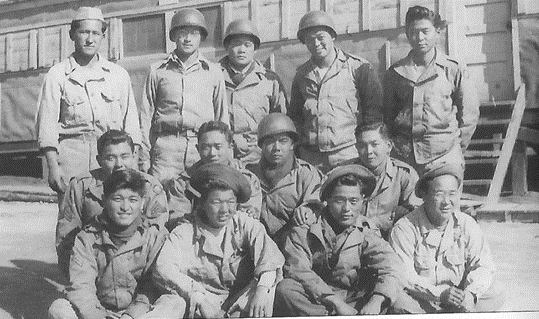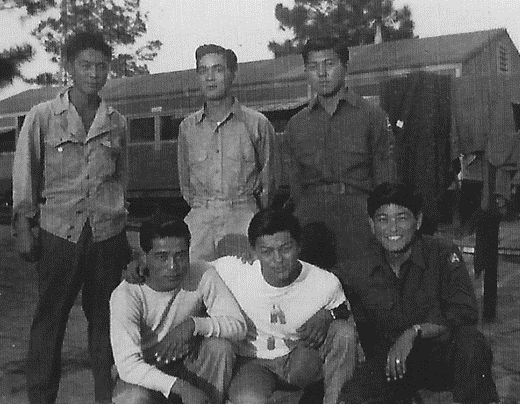
Takeo Sato
Private First Class
442nd Regimental Combat Team
3rd Battalion, I Company
Takeo Sato was born in Hilo, Hawaii Island, Territory of Hawaii, on March 23, 1922. He was the second of five sons and two daughters of Bunnosuke and Iso (Watanabe) Sato. His parents both emigrated from the village of Sugitsuma, Shinoba District, Fukushima Prefecture, Japan, respectively, in 1913 and 1919. Bunnosuke arrived on the S.S. Siberia on October 24, 1913. Iso arrived on the S.S. Tenyo Maru on October 23, 1919, by which time they were already married. They both worked at the Olaa Sugar Company initially, but by 1940 they were at the Hilo Sugar Company.

Takeo was educated at Hilo Intermediate School. In the 1940 Federal Census, he was living at home and working in the family’s cane field at Amauulu Camp No. 1. He graduated in 1941 from Hilo High School. He registered for the draft on June 30, 1942, at Local Board No. 2, at the Professional Building in Hilo. His father was his contact and lived at No. 60 Amauulu Camp No. 1. He was 5’4½” and weighed 118 pounds. He was a carpenter for the Hilo Sugar Company on Wainaka Avenue.
On March 27, 1943, Takeo Sato enlisted in the U.S. Army in Hilo. The group of 146 Big Island volunteers answered roll call at the Hilo Armory; then marched to Kalakaua Park where Colonel Foster G. Hetzel, Commanding Officer of the Hawaii Service Command, administered the oath of enlistment. This was the second enlistment of Big Island men to be accepted for service in the 442nd RCT. He was sent that day to “Boom Town,” the tent city at Schofield Barracks, with other recruits. They were given an aloha farewell ceremony by the community the next day – on March 28 – at Iolani Palace. On April 4, the new soldiers left on the S.S. Lurline for San Francisco enroute to Camp Shelby, Mississippi. Following basic training, Takeo was assigned to 3rd Battalion, I Company, 4th Platoon.
After a year of training at Camp Shelby, on April 22, 1944, the 442nd left for Camp Patrick Henry, Virginia. They shipped out to the Mediterranean Theater of Operations on May 2 in a large convoy of troop ships from Hampton Roads and arrived in Naples, Italy, the end of the month.
Takeo fought in the Rome-Arno Campaign, entering combat on June 26 near Suvereto. After fighting north up the Italian peninsula, the 442nd was sent to Marseilles, France, on September 27 to join in the Rhineland-Vosges Campaign.
On October 10, 3rd Battalion was moved by rail from the staging area in Septemes, just outside Marseilles, up the Rhone Valley north to the Vosges. The train was an assortment of “40 and 8” boxcars. They arrived in the assembly area at Charmois-devant-Bruyères at midnight on October 13. At 2:00 p.m. the next day, the Combat Team began moving into position to attack the important road center of Bruyères the following morning.
After several days of intense fighting, the enemy had been cleared from the town and its surrounding hills, and on October 23 the 442nd was ordered to take the next town, Biffontaine. On October 24, they were finally taken off the front line and put in reserve in nearby Belmont for a rest, after eight days of heavy fighting, little to no sleep, harsh weather conditions, and many casualties.
In the afternoon of October 26, the short rest was abruptly ended when the 442nd was ordered to go into the lines the next morning and fight through to rescue the 1st Battalion of the 141st (Texas) Infantry Regiment. After moving too fast and over-reaching its support, they had become surrounded on three sides by the enemy and were unable to extricate themselves. The 2nd and 3rd Battalions of the 141st Infantry, along with other units, had tried to rescue them, but were thrown back each time they attacked.
The next few days saw an intense effort by the 442nd to break through to the “lost battalion.” On October 27, the enemy lost a tank that was within 75 yards of I Company and K Company when an I Company bazooka gunner managed to take out the tank and two German bazooka gunners. Deprived of their supporting fire, the enemy infantrymen pulled back. The 3rd Battalion did not pursue as it was impossible to maintain control in the pitch darkness.
The following morning – October 28 – all units resumed the attack and resistance was as fierce as ever. The 3rd Battalion had run into the first of a series of manned German roadblocks. Before darkness set in, they and the 100th Battalion had advanced perhaps 500 yards. Private First Class Takeo Sato was killed this day, and was interred in the U.S. Military Cemetery in nearby Epinal, France.
Private First Class Takeo Sato was awarded the Bronze Star Medal, Purple Heart Medal, Good Conduct Medal, American Campaign Medal, European-African-Middle Eastern Campaign Medal with two bronze stars, World War II Victory Medal, Distinguished Unit Badge, and Combat Infantryman Badge. Takeo was awarded the Congressional Gold Medal on October 5, 2010, along with the other veterans of the 100th/442nd Regimental Combat Team. This is the highest Congressional Civilian Medal
In 1948, the remains of Americans buried overseas began slowly to return to the US, if the family so wished. On June 5 and 6 of that year it was announced in the Honolulu newspapers that Pfc. Sato’s remains were among the ten from Hawaii that would arrive in Honolulu within the next three weeks. This was announced 48 hours after the letters of notification were sent to the next of kin – in Pfc. Sato’s case, his father Bunnosuke Sato of Amauulu Camp No. 1, Hilo. Official military escorts were to accompany the remains from Schofield Barracks to the place designated by the next of kin. On June 15, it was announced that his remains would be flown on June 18 to a local mortuary in Hilo on a 19th Troop Carrier airplane from Hickam Field. The Hilo newspaper announced on June 18 that his body had arrived that day from Honolulu by Army plane and that he would lie in state at Dodo Mortuary until June 19. His funeral service would be held on Sunday at 2:00 p.m. at his home in Amauulu Camp No. 1, followed by burial in Hawaii Veterans Cemetery (Homelani) with full military honors. He was survived by his parents, Mr. and Mrs. Bunnosuke Sato, four brothers – Fumo, Rikeo, Nobuo, and Hideo, and two sisters – Toshino and Yoshie. He was the third veteran whose remains were returned to the Big Island.
On June 25, 1948, his family published a Card of Thanks in the Hawaii Herald-Tribune of Hilo, thanking their many friends and relatives for the floral offerings and sympathy during the recent memorial and burial services for their son Pfc. Takeo Sato. Among those thanked were: Reverend Masao Yamada, Amauulu Veterans Club, Amauulu Athletic Club, Company I (442nd), Kilauea Military Camp Boys, Hilo High School Class of 1941, AJA Veterans Club, American Legion Auxiliary and Hilo Post No. 3. His father ordered his tombstone on June 19, 1948, and it was to come from West Chelmsford, Massachusetts, on December 1.
Private First Class Takeo Sato was later sent to Honolulu and reinterred at the National Memorial Cemetery of the Pacific at Punchbowl in Section V, Site 285 on July 28, 1949.

4th Squad at Camp Shelby: Above Pfc. Sato, middle row, far right; Below, top row, center

Researched and written by the Sons & Daughters of the 442nd Regimental Combat Team in 2021.
